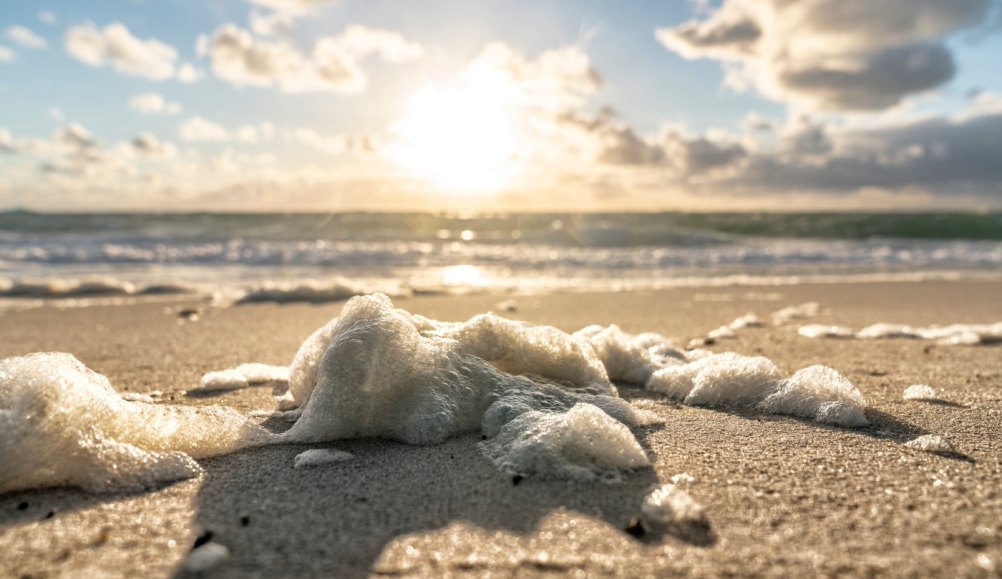
Light could help water evaporate by breaking bonds between molecules, scientists propose. In nature, this process could occur where water contacts air, such as in sea-foam or in soils.
Tina Terras & Michael Walter/Moment/Getty Images
- More than 2 years ago
Read another version of this article at Science News Explores
Green light means “go.” That might apply to evaporating water molecules too.
Visible light, especially that of a greenish hue, might spur water to evaporate, researchers report in the Nov. 7 Proceedings of the National Academy of Sciences. In experiments, water evaporating under visible light showed a higher evaporation rate than possible based on heat alone, MIT mechanical engineer Gang Chen and colleagues say.
Coupled with other observations, they say, the finding suggests that when light shines on water, individual particles of light, or photons, can sever the bonds that connect water molecules, releasing clusters of molecules into the air.
“This is super exciting stuff,” says Yuki Nagata, a chemist at the Max Planck Institute for Polymer Research in Mainz, Germany, who was not part of the research. He notes that the hypothesis needs additional checking. “We are not 100 percent sure this is really the mechanism,” he says. But if it is, it’s “totally new.”
Normally, heat is what gets evaporation going, causing water molecules in the liquid to jostle more vigorously. That extra energy can break some of the bonds between molecules in the liquid, allowing molecules to escape as water vapor. Based on how much heat goes in, scientists can calculate the amount of evaporation expected. Visible light can help water evaporate due to the heat it imparts (SN: 3/8/16). But until now, it wasn’t thought to directly break the bonds between water molecules.
In the new study, the researchers shone light on water contained in porous hydrogels, materials that greedily sop up water. The proposed effect occurs where air meets water, and the hydrogels the researchers studied contain innumerable crannies where the two meet, allowing the water to be cleaved off and escape. In some cases, the evaporation rate was more than double the expectation based on heat. What’s more, the evaporation rate varied with the wavelength of the light. Green light produced the highest evaporation rate.
That wavelength dependence is convincing support for the researchers’ hypothesis, says thermodynamicist Janet A.W. Elliott of the University of Alberta in Edmonton, Canada. “If you just shine [visible] light on something, how do you know if it’s the light or the heat from the light that’s doing your job? But if it’s wavelength dependent … that’s evidence that the light part of it matters.” Additionally, she says, the excess evaporation didn’t occur when a heater was used instead of light.
When heat drives evaporation, molecules typically escape one at a time. But measurements of the temperature of the vapor above the hydrogel suggest that when light is driving the evaporation, water molecules escape in clusters. Then the clusters themselves evaporate, breaking into individual water molecules, cooling the vapor in the process.
In general, the measured vapor temperature was higher closer to the hydrogel, just as steam is hottest directly above a boiling pan. But in a pocket of vapor between about 8 to 14 millimeters above the surface, the temperature didn’t vary with height. That, the researchers say, is evidence of a region where the air is saturated with individual water molecules, and where clusters continually evaporate and recondense.
“It’s pretty convincing that, in this particular experimental setup, you can see clumps of molecules coming off and then those clumps evaporate,” Elliott says.
But, Elliott says, “there’s still lots of questions to be answered.” For example, the researchers don’t explain in detail how the photons could break the bonds or why it works best with green light.
Chen admits that the theoretical explanation involves some handwaving. Still, he hopes that this effect could be put to use for practical purposes, such as more efficient ways of making freshwater from saltwater (SN: 8/9/16)
The effect might be widespread in nature, Chen says, in water within porous materials like soil or plants, or in foams on the surface of the ocean. “We have a feeling this is really happening daily, widely, and that’s why we’re very excited about this.”







